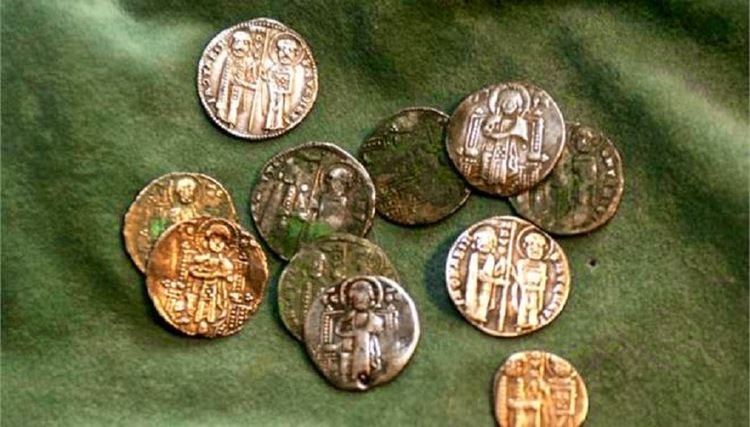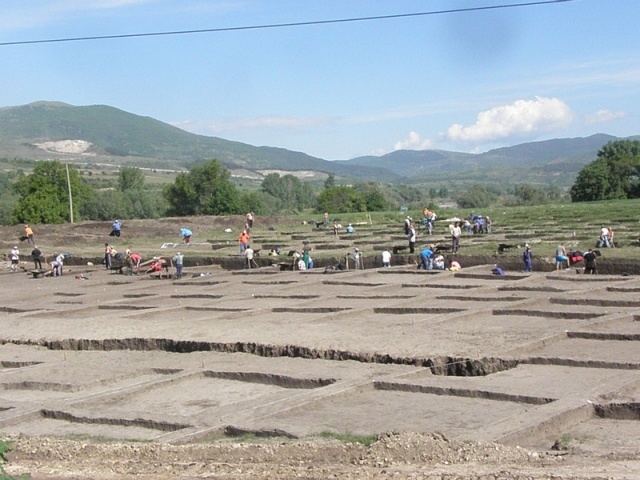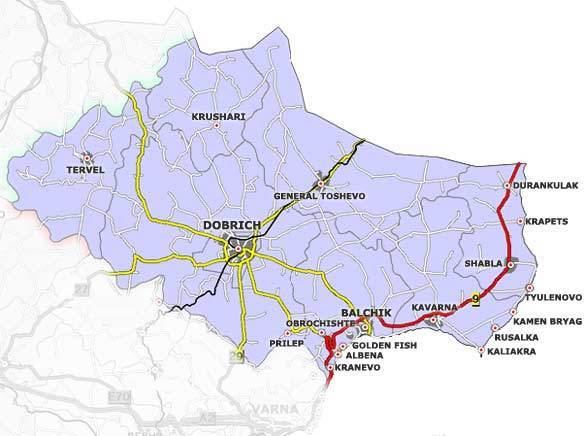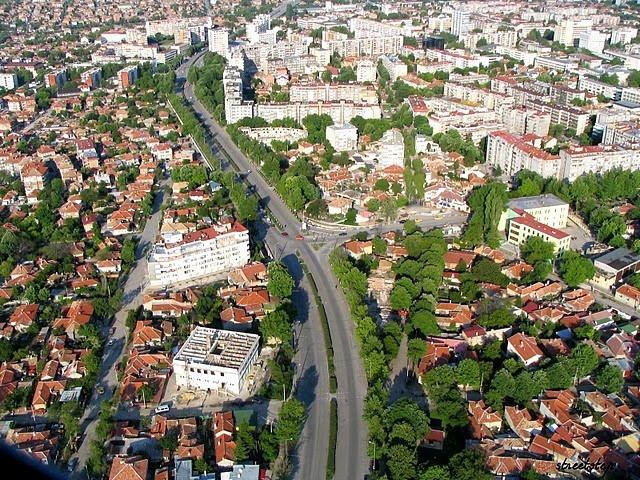Country Bulgaria Area 109.018 km2 Population 110 150 | University HRC Culinary Academy Mayor Detelina Nikolova | |
 | ||
Map of Dobrich
Dobrich (Bulgarian: Добрич) is the eight most populated city in Bulgaria, the administrative centre of Dobrich Province and the capital of the region of Southern Dobrudzha. It is located in the northeastern part of the country, 30 km west of the Bulgarian Black Sea Coast, not far from resorts such as Albena, Balchik, and Golden Sands. In January 2012, Dobrich was inhabited by 90,375 people within the city limits, while along with the legally affiliated adjacent villages the population was 112,203 inhabitants. The city is named after the Bulgarian medieval lord of the surrounding region - Dobrotitsa. Agriculture is the most developed branch of the economy.
Contents
- Map of Dobrich
- Winnie banov preaches in dobrich bulgaria
- Dobrich city park bulgaria
- Etymology
- History
- Titular see of Abrittum
- Air
- Water resources
- Noise
- Green areas
- Waste
- Economy
- Agriculture
- Gasification
- Population
- Ethnic and religious composition
- Church St George
- Holy Trinity Church
- Armenian Church Saint Hovhaness
- Towns and villages
- The City Park St George
- Dobrich TV Tower
- Education
- Nature and Animal Protection Centre
- Notable people from Dobrich
- Twin cities
- References

Dobrich Knoll on Livingston Island in the South Shetland Islands, Antarctica is named after Dobrich. A point of interest is the Dobrich TV Tower.

Winnie banov preaches in dobrich bulgaria
Dobrich city park bulgaria
Etymology

The city is named after the 14th-century Dobrujan ruler Dobrotitsa, from the Slavic root dobr, "good"
History
The first evidence of settlement in what is now Dobrich dates from the 4th or 3rd century BC. Under the Latin name Abrittum, it was a city of the Roman province of Moesia Inferior, important enough to become a suffragan bishopric of the Metropolitan of the capital, Marcianopolis, but the Catholic diocese faded later. Ruins from 2nd to 4th centuries AD and the 7th to 11th centuries have also been found, including a Bulgar necropolis featuring pagan graves in the centre of the city.
During the 11th century, Pecheneg invasions devastated the interior of Dobruja, leaving many settlements in the region uninhabited at the time of the Second Bulgarian Empire.
The settlement was founded for a second time in the 16th century by the Turkish merchant Hacıoğlu Pazarcık, whose name it bore until 1882. According to Ottoman data from 1646–1650, there were over 1,000 houses in the city, about 100 shops, three inns, three Turkish baths, twelve mosques and twelve schools. From the 17th to the 19th century, the city developed as a handicraft, trade and agricultural centre, being famous for its weaving, homespun tailoring, coppersmith's trade, leather-work and agricultural products, such as wheat, linseed, wool and cheese. At the beginning of the 19th century, the city's population reached 12,000, many of whom refugees from eastern Bulgaria after the Russo-Turkish Wars. The cultural appearance of the city was also formed. The first Orthodox church was built in 1843. The city was liberated from the Ottoman Empire on 27 January 1878 and renamed Dobrich on 19 February 1882.
After the Treaty of Bucharest of 1913 (confirmed by the Treaty of Neuilly of 1919), Dobrich and the whole of Southern Dobruja were incorporated in Romania for a period until 1940. During that time, the city bore the name Bazargic, which is a transformation of the earlier Turkish name Hacıoğlu Pazarcık, and was centre of Caliacra County (județ in Romanian). On 25 September 1940, the Bulgarian army marched into the city after signing Treaty of Craiova on September 7, 1940; date celebrated as the city's holiday, later changed to September 25.
In 1949, during the period of Communist rule, Dobrich was renamed Tolbukhin (Толбухин) after Marshal of the Soviet Union Fyodor Tolbukhin. On 19 September 1990, a presidential decree restored the city's old name of Dobrich. Despite the renewing of the name Dobrich architecturally maintains an ex-communist outlook even in the 21st century. The vehicle registration plate code for the region has also remained unchanged. It is the abbreviation TX (from ТолбуХин; Тolbukhin).
Titular see of Abrittum
The diocese was nominally restored as a Latin titular bishopric, initially under the name 'Abrytus (Abryus in 19922-24), changed to Abrittum in 1925.
It has had the following incumbents, all of the lowest (episcopal) rank :
Air
In the municipality of Dobrich, the quality of atmospheric air is monitored by the mobile station for emission control of the Regional Inspectorate for the Environment and Water Resources (RIEWR) - Varna. The station is equipped with automatic monitoring devices measuring the quantities of carbon oxide, ozone, nitrogen oxides, sulfuric dioxide, and fine dust particles. The municipality is implementing a program for decreasing the quantities of dust particles, which was adopted by the municipal council in 2003.
Water resources
Surface water resources are insufficient in the region. The town is supplied with water from drill wells and water catchment areas located near the town. Eight pumping stations provide bacteria-free drinking water which does not even need further treatment. The water sources are in constant operation. A security area surrounds each source, and the water distribution is controlled by computers. The municipality boasts a complete water supply network.
Noise
In the municipality of Dobrich, there are three sources of noise - the industries, the households, and the construction works. Street noise is measured at over 20 sites. The high levels of noise in the industrial areas affect only the people working there. The levels of noise in the residential areas situated away from the town centre are quite acceptable, and the lowest levels can be found in the town parks.
Green areas
The municipal Green System Plan examines the status of the existing urban and suburban green areas, as well as the variety of the plant species. The Green System includes the following categories of green areas: public parks and gardens, special parks and gardens, sanitary/protective greening, transportation greening (streets and roads), and limited-usage greening.
Waste
The types of waste in the municipality can be defined as household, construction, industrial, and hazardous waste. Waste accumulation is around the average for the country. However, it is twice as much as that in the developed countries. The industrial waste is varied. Due to the economic crisis after 1989, industrial activity in the region subsided.In March 2000, the activities related to waste collection and transportation were taken over by Scheele Bulgaria, a wholly owned subsidiary of Scheele.All waste is dumped in the waste depot near the village of Bogdan, located about 5 km away from the town of Dobrich.
Economy
The general condition of Dobrich District cannot be described as good. GDP per capita is only 69% of the national average of BGN 9,359. Unemployment remains relatively high despite the marked revitalisation of the labour market in 2012. Household incomes are rising, but the companies show no optimism for the future. The district has one of the most developed agricultural sectors in the country, generating nearly a quarter of all company revenues in the district. Mostly grain is grown, which also brings some negatives. Grain production does not create many jobs, and to some extent is the cause of nitrate pollution. The population in the district has been decreasing at a faster rate than the national average, but still maintains a relatively positive age structure. Education and health are inadequate. The rate of enrolment in schools has declined, while the number of dropouts is still high. In terms of medical services, there is a pressing need for specialists. Nearly 40% of those in need of treatment in the past 12 months have sought such treatment outside the district. The district has potential for development, but there is a need for bolder reforms in the business environment.
Agriculture
Agriculture is the most developed branch of the economy. The main reason for this is the environment – climate, soils and clean lands. 81% of all the land in Dobrich is agricultural, almost 4,000,000 decares. More than 70% of it is cultivated, which makes Dobrich №1 cultivated region in the country. Farming, plant-growing and stock-breeding are the most important part of the economy in Dobrich. Dobrudja territory, called the “granary of Bulgaria” is part of the district. Some of the end products made in Dobrich are: bread and flour products, all kinds of sausages, milk and dairy products, poultry products, margarine and vegetable oils, wine, soft drinks. The biggest bird-farm is located in the district. Other factories of great importance are the milk factory (one of the biggest factories in Bulgaria), the bread factory (one of the biggest factories in Bulgaria). Additional important products from other industries are cement, electric appliances, clothes, confection, furniture, car batteries, containers and there are many other factories from the food and beverage industry.
Gasification
The municipal strategy provides that the household, utility and industrial sectors be supplied with gas under a project for gasification. The network of gas pipelines has been extended to 43,808 metres. Currently we are working on the gasification of the residential areas.All municipal establishments from the educational, administrative, healthcare and social service sectors have already been covered by the gas supply network.Communications Dobrich has six offices for postal services. They cover the whole territory of the town thus meeting the needs of the community for such services. The municipality of Dobrich is wired by two local landline telecommunication networks which operate four analogue and one digital exchanges.
Population
In January 2012, Dobrich was inhabited by 90 375 people within the city limits, while along with the legally affiliated adjacent villages the population was 112 203 inhabitants. The number of the residents of the city (not the municipality) reached its peak in the period 1986-1991 when exceeded 110,000. The following table presents the change of the population after 1887.
Ethnic and religious composition
According to the latest 2011 census data, the individuals declared their ethnic identity were distributed as follows:
Total: 91,030
The percentage of Orthodox Christians, according to the 2001 census data, is 86%, whereas around 10% of the population are adherents of the Muslim faith.
Church "St. George"
The church is the oldest church from the Revival period in Dobrich. It is located in the center of the town, in the immediate vicinity of the Ethnographic house. The building is a cultural heritage site. It was built in 1864, on the spot of an older Christian church from 1843 that burned down during the Crimean War, together with the lower Bulgarian neighborhood.
In an architectural sense, the new church is a three-nave basilica. It was built with the donations of the Bulgarian population in Dobrich and the Dobrich district, in the courtyard of the great Bulgarian Revival figure Ivan Hadzhi Valkov. It is assumed that the church was made by unknown craftsmen who belonged or at least were familiar with the school of the famous Bulgarian master Kolyu Ficheto. The frescoes inside are made by Kozma Blazhenov, a representative of the Debar Art School, who also made the engraved iconostasis. The icons were painted by painters famous at the time – Nedko Todorovic from Zheravna, Haralambi Todorov from Pirdop and Nikolay Vasilev from Shumen. The church was consecrated in 1889 by Bishop Simeon.
“Holy Trinity” Church
The “Holy Trinity” church is located in the center of Dobrich. The older church building that was situated at this place was built in 1859, to the left of the entrance of today’s church. It was later joined by the first school in the town, where the mutual instruction approach was used. The present church was built in 1911. Architecturally speaking, it is a classic three-nave basilica, a dome and a bell tower. The icons of its iconostasis were painted by Gospodin Zhelyazkov, a student of Repin.
Armenian Church “Saint Hovhaness”
It was built in 1894, replacing an old temple from 1830. It was designed by Italian architects. It is a one-nave church with stone foundations and walls and a wooden roof. In the temple you can see original images of Armenian saints painted in the 19th century.
Towns and villages
The Municipality of Dobrich has a special status - the territory of the municipality holds only the town of Dobrich with a population of 91030 people. Transport system The road and communication network provides access to all parts of the region and to other regions in Bulgaria. Rail provides convenient and cheap travel to the capital city, the Black Sea coast, and to some European countries. Street network The street network has been expanded according to the detailed urban development plans and the particulars of the terrain. A ring road regulates the direct and the outgoing traffic to Varna, Albena, Balchik, General Toshevo, Silistra, Shumen and Russe. The street network of the town (total length 165 km, of which 60 km main streets) takes the incoming and the internal traffic.
The City Park St. George
The City Park St. George or the city garden as known among people of Dobrich is the most visited place in Dobrich by its citizens and guests. In the far year of 1867 Bildieto (the City Municipal Council) selects a place in the neighborhood of Karabokluka for establishment of the first city garden. An enormous contribution for development of the city-park art has the family of Gradinarovi.Its area is 430 dca and is divided into several sectors – “The Old Garden”, Children’s sector – a zone for games and fun, park lakes zone, zone of rock terrace gardens, sports zone etc. In 1999 the old garden of the city park is announced to be a monument of culture and garden park art. The park is located immediately next to the central pedestrian zone in Dobrich.The park is one of the five oldest city parks in the country. It covers – the old garden, declared to be a cultural heritage site, a children's area, lakes, terraced rock gardens and a sports area. Even today the visitors can see some plant species imported from Europe at the beginning of the last century. The park hosts also one on the town museums, with a separate room for temporary and visiting exhibitions.
Dobrich TV Tower
Dobrich TV Tower houses broadcasting equipment for radio, television and telecommunications. It is 146 metres tall and built of reinforced concrete. The tower, which was designed by Petar Andreev, was completed in 1979 and has an observation deck open for tourists. It is also remarkable by its design.
Education
The activities of the Department of "Education and Culture" in secondary education are conducted in accordance with the requirements of the Education Act, the regulations implementing the Education Act and are consistent with the educational policy of Dobrich Municipality. Educational policy in general considers socio-economic characteristics of modern society as well as prospects for future development. In this sense today it is important to reconsider the capacity of Bulgarian schools to respond to the new challenges adequately.
The existing school network in the city sufficiently meets the interests of young people as well as the needs of economy. At this stage the territorial model meets the need of accessibility. There is a secondary school in each sub region of the city, which is near the students' place of residence. This allows free and compulsory education for all. The manager's office, "Humanitarian Activities" - Section "Education and Culture" Dobrich, is the specialized authority for management of municipal kindergartens and schools. It is located at: Dobrich, st. "Nezvisimost" 7 Neicho Neychev - Head of "Education and Culture"
At the beginning of 2013/2014, the education network in the city of Dobrich includes 17 kindergartens, 7 elementary schools, 5 middle schools, 3 specialized schools, 7 vocational schools, a sport school, a subsidiary school, 2 private schools, student dormitories, a dormitory and Municipal Youth Center "Zahari Stoyanov".
The number of pupils in primary schools is 2362 and the number of classes 107.
In 5 secondary schools, a sports schools and 3 specialized high schools ar trained 6090 students in 265 classes. Profile subjects in the schools: Humanities, Sciences, Foreign Language and Technology. Profile subjects such as Music, Art and Sport are also available to choose.
From the approved state plan for the admission of pupils on completion of seventh grade in local schools, including 16 classes were implemented 16. After completing basic education are formed 5 classes.
In market conditions vocational education in municipality is held in 7 vocational schools located in different areas of the city. During the school year 2013/2014 1598 students are trained in 26 majors and professions in 73 classes. Each professional school has its own building and facilities for practical training. Private schools in the territory of Dobrich are 2 with a total of 95 students in 16 classes.
Programmes: Management, Industrial management, Business administration.
Programmes: Pre-school pedagogics and foreign languages, Primary school pedagogics and foreign languages, Design and technology, Art, Information technology, Library operations, Farming (specialization in agricultural economics and rural tourism), Public administration, Public Relations, Tourism.
Programmes: Marketing and management of the hospitality industry, Marketing and management, Agricultural economics, Hotel management, International business and management.
There are about 30 high schools, 19 kindergartens and 3 mangers in Dobrich.
Nature and Animal Protection Centre
The centre is the only one of its kind not only in Bulgaria but also in Eastern Europe. Founded under a Bulgarian-Swiss project, it boasts an area of 16 hectares, 30-year-old vegetation (trees and bushes), and a convenient access. The zoo houses over 100 animal species - deer, roe, llamas, mouflons, Przhevalski's horses, goat, pheasants, bison, exotic and water birds, etc. - which live in conditions very close to their natural habitats. A priority for the zoo is the reproduction and re-introduction of endangered animal species.
